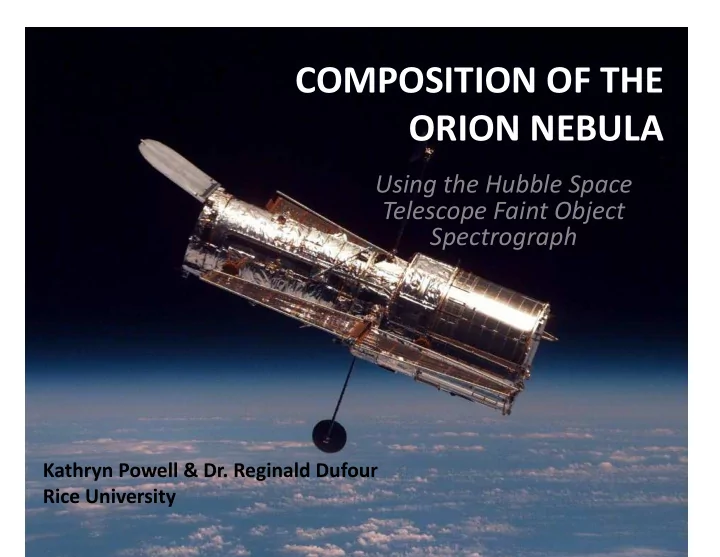

COMPOSITION ¡OF ¡THE ¡ ¡ ORION ¡NEBULA ¡ Using ¡the ¡Hubble ¡Space ¡ Telescope ¡Faint ¡Object ¡ Spectrograph ¡ Kathryn ¡Powell ¡& ¡Dr. ¡Reginald ¡Dufour ¡ Rice ¡University ¡
Motivation ¡ • Analyze ¡elemental ¡abundances ¡in ¡the ¡Orion ¡ Nebula ¡with ¡HST ¡FOS ¡data ¡ • Ability ¡to ¡analyze ¡data ¡from ¡UV ¡and ¡visible ¡ regions ¡with ¡the ¡ same ¡instrument ¡ observing ¡ the ¡ same ¡position ¡ in ¡the ¡nebula ¡ • UV ¡data ¡enables ¡determination ¡of ¡carbon ¡ abundances ¡
HII ¡regions ¡ ¡ • Clouds ¡of ¡ionized ¡gas ¡ • Regions ¡of ¡recent ¡star ¡ formation ¡ • Orion ¡Nebula ¡is ¡the ¡ closest ¡H ¡II ¡region ¡ (1344 ¡light ¡years) ¡
Collisionally ¡excited ¡lines ¡ • “Forbidden” ¡lines ¡ – Transitions ¡produce ¡lines ¡not ¡observed ¡in ¡the ¡ lab; ¡very ¡unlikely ¡under ¡normal ¡conditions ¡ – Observed ¡in ¡low-‑density ¡gases ¡where ¡atomic ¡ collisions ¡are ¡infrequent, ¡like ¡H ¡II ¡regions! ¡ – Notated ¡by ¡square ¡brackets: ¡O++ ¡ ¡[O ¡III] ¡ • Measure ¡the ¡intensities ¡of ¡these ¡lines ¡to ¡ learn ¡about ¡conditions ¡in ¡the ¡nebula ¡
Measuring ¡Line ¡Intensi)es ¡
Reddening ¡Correc)on ¡ I ( H β ) = F ( λ ) I ( λ ) F ( H β )10 c [ f ( λ ) − f ( H β )] extinction ¡correction ¡ reddening-‑ ¡ parameter ¡that ¡varies ¡ measured ¡flux ¡ corrected ¡flux ¡ with ¡wavelength ¡ c = log 10 (2.86) − log( H α H β ) Hα, ¡Hβ ¡ : ¡Balmer ¡lines ¡of ¡hydrogen ¡ − 0.274
nebular ¡ • Package ¡in ¡Space ¡Telescope ¡Science ¡Data ¡ Analysis ¡System ¡ • Shaw ¡& ¡Dufour ¡(1995) ¡ • Calculate ¡temperatures, ¡densities, ¡and ¡ abundances ¡in ¡IRAF ¡ ¡
Temperature ¡and ¡Density ¡Calculations ¡ • Strength ¡of ¡the ¡ forbidden ¡lines ¡is ¡very ¡ T e ( OIII ) = (4959 + 5007) sensitive ¡to ¡ 4363 temperature ¡ T e ( NII ) = (6548 + 6584) • Due ¡to ¡weak/noisy ¡lines ¡ 5755 needed ¡to ¡determine ¡ temperature, ¡values ¡ N e ( SII ) = 6716 presented ¡here ¡are ¡ 6731 from ¡the ¡literature ¡
Abundance ¡Calcula)ons ¡ Ionic ¡abundances ¡ Total ¡elemental ¡abundances ¡ -‑Where ¡possible, ¡sum ¡the ¡ O/H ¡= ¡(O + ¡+O ++ ¡ )/H + ¡ contribution ¡from ¡multiple ¡ excitation ¡states ¡ S/H ¡= ¡(S + + ¡S ++ )/H + ¡ N/H ¡= ¡(N + /O + )*(O/H) ¡ -‑Otherwise, ¡take ¡advantage ¡of ¡ similar ¡ionization ¡potentials ¡ Ne/H ¡= ¡(Ne ++ /O ++ )*(O/H) ¡ and ¡use ¡O/H ¡correction ¡factor ¡ C/H ¡= ¡(C ++ /O ++ )*(O/H) ¡ -‑log(X/H) ¡+ ¡12 ¡
Elemental ¡Abundances ¡ log(X/H) ¡+ ¡12 ¡ ¡ Object ¡ C ¡ N ¡ O ¡ Ne ¡ S ¡ Orion ¡1SW ¡ 8.66 ¡ 7.88 ¡8.46 ¡ 7.76 ¡6.98 ¡ Orion ¡X2 ¡ 8.44 ¡ 7.65 ¡8.51 ¡ 7.64 ¡6.95 ¡ Orion* ¡ 8.39 ¡ 7.62 ¡8.48 ¡ 7.70 ¡6.97 ¡ Solar* ¡ 8.59 ¡ 7.92 ¡8.69 ¡ 8.08 ¡7.32 ¡ *Stasinska, G. (2004) In Cosmochemistry: The Melting Pot of the Elements, Cambridge U. Press.
Conclusions ¡ • Determined ¡elemental ¡abundances ¡in ¡the ¡ Orion ¡Nebula ¡from ¡collisionally ¡excited ¡ spectral ¡lines ¡ • Found ¡consistent ¡abundances ¡with ¡FOS ¡ spectra ¡ – Oxygen ¡consistent ¡with ¡literature ¡ – Carbon ¡within ¡reasonable ¡limits ¡ • Not ¡able ¡to ¡determine ¡temperatures ¡precisely ¡ enough ¡with ¡HST ¡FOS ¡
Recommend
More recommend